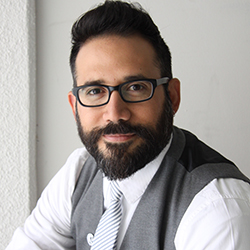
For the first time, students in a Knight Center MOOC (massive open online course) will be viewing some lessons in 360 degrees through interactive videos.
In our newest MOOC, “Introduction to Immersive Journalism: Virtual Reality and 360 Video,” we will be using some of the very tools taught in the course. Watch this video of MOOC instructor, professor Robert Hernandez, explaining course content using 360 video.

Immersive journalism, based on virtual reality and 360 video, has been used around the world as a new narrative format that allows reporters to tell stories and, at the same time, bring the audience to the places they want to show, as never before. It’s a skill that is in demand within news organizations that have experimented or want to start experimenting with the new tool that allows for immersive storytelling.
The new course starts on March 6 and ends on April 9, 2017. In just five weeks, you will learn how to prepare your first virtual reality and 360 video production.
Click here to register now for this free online course.
The MOOC’s five modules will look at the evolution of virtual reality and its use in journalism, different VR experiences and consumption formats, immersive projects currently being produced for journalism, as well as production hardware and software.
Hernandez will also be joined by pioneers in immersive journalism in the United States who will share lessons learned and tips, as well as discuss ethical challenges presented by the new storytelling medium.
“Virtual reality isn’t coming, it’s already here. This course is aimed to prepare you to understand how you can not only embrace this technology, but be a leader in it,” said Hernandez. He believes the emerging technologies of virtual reality and augmented reality will be the industry’s next disruption.
“This is a unique course because it’s one of the first [on virtual reality and 360 video] that is going to be offered to a wide audience. I do workshops, I do trainings, and of course, I teach at my institution, but this is making this new emerging technology and platform more widely available,” Hernandez said.
As with all Knight Center courses, Hernandez will use video in his lessons. However, some of these videos will be in 360°. He will also use presentations, readings, discussion forums and weekly quizzes.
The course is designed for journalists, but is open to anyone interested in telling stories using 360 video, virtual reality and augmented reality. Students will need Wi-Fi and a strong internet connection, a modern desktop browser that can display 360 videos and a smartphone (iOS or Android).
“Since the inception of the Knight Center, we have been helping thousands of journalists to learn new techniques and adapt to the new media ecosystem created by the digital revolution,” said professor Rosental Alves, founder and director of the Knight Center for Journalism in the Americas at the University of Texas at Austin. “Immersive journalism seems to be a new frontier, opening new ways for audio-visual storytelling. We are delighted to have attracted my colleague Robert Hernandez to teach this course, as he is one of the foremost experts in this field in the United States.”
Like all Knight Center courses, Intro to Immersive Journalism is asynchronous, meaning students can log into the course and complete activities throughout the week at their own pace. However, there are weekly deadlines for each module.
The course is free, but participants who want to receive a certificate of completion must comply with course requirements, apply for the certificate and pay an online administrative fee of $30 using an international credit card. The certificate will be issued only to students who have actively participated in the course and completed the proposed tests and exercises. The certificates can be downloaded from the internet in PDF format after the Knight Center verifies that course requirements were met. No formal course credit of any kind is associated with this certificate.
Robert Hernandez refers to himself as a “hackademic” who specializes in “MacGyvering” web journalism solutions. A veteran of digital journalism, he currently teaches advanced multimedia storytelling, augmented reality journalism, and more at the University of Southern California’s Annenberg School. He has worked at seattletimes.com, SFGate.com, eXaminer.com, La Prensa Gráfica, and others.
Hernandez previously collaborated with the Knight Center in 2014 as an instructor of the MOOC Introduction to Mobile Journalism. In 2015, he chaired the panel “The arrival of virtual-reality journalism: Using immersive 3D devices for experiential storytelling” at the International Symposium of Online Journalism, which is organized by the Knight Center.
The Knight Center for Journalism in the Americas was created in 2002 by Professor Rosental Alves, Knight Chair in Journalism and UNESCO Chair in Communication at the School of Journalism at the University of Texas at Austin. The Knight Center’s distance learning program continues with support from the John S. and James L. Knight Foundation, the Moody College of Communication at the University of Texas and other donors; as well as income from registration fees and the issuance of certificates. Since 2012, the MOOCs and other online journalism courses from the Knight Center have reached more than 90,000 people from 169 countries.
The video below is a 360 video. To move it around in different directions, you can drag your mouse across the video display.